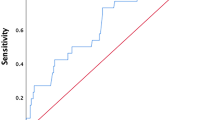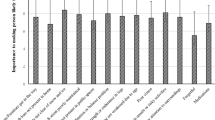Abstract
The purpose of this study was to administer clinical balance measures in community-dwelling adults with unilateral lower extremity (LE) amputations and determine optimal cut-off scores for identifying fallers. A cross-sectional study was conducted on a convenience sample of 40 independently ambulatory participants with unilateral LE amputations and a prosthetic device (20 fallers and 20 nonfallers) who were tested during a single session using: the Amputee Mobility Predictor with Prosthesis (AMP PRO), Functional Reach (FR), Single Limb Stance (SLS) and the Timed-Up-and-GO (TUG). There was a statistically significant difference on the AMP PRO (4.75 points.; 95% CI 1.10–8.40) for fallers (36.95 out of 47, SD 7.43) compared with nonfallers (41.70 out of 47, SD 3.13) and on the TUG (4.17 s., 95% CI 0.65–7.69) for fallers (14.84 s, SD 7.33) versus nonfallers (10.67 s, SD 2.64). The AMP PRO had a moderate Area Under the Curve (AUC) predictive value of 0.70 with an optimal cut-off score of 39.5 out of 47 total points (sensitivity 80%, specificity 60%) for identification of fallers. For the TUG, there was a moderate AUC value of 0.68 (sensitivity 70%, specificity 60%) when using a cut-off score of 10.03 s. There was a moderate to high correlation between the AMP PRO and TUG both between (r = −0.77) and within (r = −0.68) groups indicating that they measure similar constructs. Limitations included a heterogeneous sample and self-report of fall history. Both the AMP PRO and the TUG provide acceptable sensitivity and specificity for identifying fallers among community-dwelling adults with LE amputation.
Similar content being viewed by others
References
Bennie, S., Bruner, K., Dizon, A., & Peterson, S. (2003). Measurements of balance: Comparison of the timed “up and go” test and functional reach test with the berg balance scale. Journal of Physical Therapy Science, 15, 93–97.
Brooks, D., Parsons, J., Hunter, J. P., Devlin, M., & Walker, J. (2001). The 2-minute walk test as a measure of functional improvement in persons with lower limb amputation. Archives of Physical Medicine and Rehabilitation, 82, 1478–1483.
Brooks, D., Hunter, J. P., Parsons, J., Livsey, E., Quirt, J., & Devlin, M. (2002). Reliability of the two-minute walk test in individuals with transtibial amputation. Archives of Physical Medicine and Rehabilitation, 83, 1562–1565.
Centers for Disease Control and Prevention. (2016). Diagnosed diabetes. United States diabetes surveillance system. Retrieved from http://gis.cdc.gov/grasp/diabetes/DiabetesAtlas.html#. Accessed 28 Feb 2017.
Deathe, A. B., & Miller, W. C. (2005). The L test of functional mobility: Measurement properties of a modified version of the timed ‘up & go’ test designed for people with lower-limb amputations. Physical Therapy, 85, 626–635.
Deathe, A. B., Wolfe, D. L., Devlin, M., Hebert, J. S., Miller, W. C., & Pallaveshi, L. (2009). Selection of outcome measures in lower extremity amputation rehabilitation: ICF activities. Disability and Rehabilitation, 31(18), 1455–1473.
Dillingham, T. R., Pezzin, L. E., & MacKenzie, E. J. (2002). Limb amputation and limb deficiency: Epidemiology and recent trends in the United States. Southern Medical Journal, 95, 875–883.
Dite, W., Connor, H. J., & Curtis, H. J. (2007). Clinical identification of multiple fall risk early after unilateral transtibial amputation. Archives of Physical Medicine and Rehabilitation, 88, 109–114.
Drusini, A. G., Eleazer, G. P., Caiazzo, M., & Wieland, G. D. (2002). One-leg standing balance and functional status in an elderly community-dwelling population in Northeast Italy. Aging Clinical and Experimental Research, 14, 42–46.
Duncan, P. W., Weiner, D. K., Chandler, J., & Studenski, S. (1990). Functional reach: A new clinical measure of balance. Journal of Gerontology, 45(6), M192–M197.
Franchignoni, F., Tesio, L., Martino, M. T., & Ricupero, C. (1998). Reliability of four simple, quantitative tests of balance and mobility in healthy elderly females. Aging, 10(1), 26–31.
Gailey, R. S., Roach, K. E., Applegate, E. B., Cho, B., Cunniffe, B., Licht, S., Maquire, M., & Nash, M. S. (2002). The amputee mobility predictor: An instrument to assess determinants of the lower-limb amputee’s ability to ambulate. Archives of Physical Medicine and Rehabilitation., 83, 613–627.
Gallagher, E. J. (1998). Clinical utility of likelihood ratios. Annals of Emergency Medicine, 31, 391–397.
Gauthier-Gagnon, C., Grise, M., & Lepage, Y. (1998). The locomotor capabilities index: Content validity. Journal of Rehabilitation Outcome Measures, 2, 40–46.
Habibzadeh, F., Habibzadeh, P., & Yadollahie, M. (2016). On determining the most appropriate test cut-off value: The case of tests with continuous results. Biochemia Medica, 26(3), 297–307.
Hanley, J. A., & McNeil, B. J. (1982). The meaning and use of the area under a receiver operating characteristic (ROC) curve. Radiology, 143, 29–36.
Hunter, S. W., Batchelor, F., Hill, K. D., Hill, A. M., Mackintosh, S., & Payne, M. (2017). Risk factors for falls in people with a lower limb amputation: A systematic review. Physical Medicine and Rehabilitation, 9(2), 170–180.
Hurvitz, E. A., Richardson, J. K., Werner, R. A., Ruhl, A. M., & Dixon, M. R. (2000). Unipedal stance testing as an indicator of fall risk among older outpatients. Archives of Physical Medicine and Rehabilitation, 81(5, 587–591.
Kinugasa, T., Nagasaki, H., Furuna, T., & Itoh, H. (1996). Physical performance measures for characterizing high functioning older persons. Aging and Physical Activity, 4, 338–348.
Legro, M. W., Reiber, G. D., Smith, D. G., del Agulia, M., Larsen, J., & Boone, D. (1998). Prosthesis evaluation questionnaire for persons with lower limb amputations: Assessing prosthesis-related quality of life. Archives of Physical Medicine and Rehabilitation., 79, 931–938.
Lim, L. I., van Wegen, E. E., de Goede, C. J. T., Jones, D., Rochester, L., Hetherington, V., Nieuwboer, A., Willems, A. M., & Kwakkel, G. (2005). Measuring gait and gait-related activities in Parkinson's patients own home environment: A reliability, responsiveness and feasibility study. Parkinsonism and Related Disorders, 11(1), 19–24.
MacRae, P. G., Lacourse, M., & Moldavon, R. (1992). Physical performance measures that predict faller status in community-dwelling older adults. The Journal of Orthopaedic and Sports Physical Therapy, 16, 123–128.
Maki, B. E., Holliday, P. J., & Topper, A. K. (1991). Fear of falling and postural performance in the elderly. Journal of Gerontology., 46, M123–M1121.
Miller, W. C., Speechley, M., & Deathe, B. (2001). The prevalence and risk factors of falling and fear of falling among lower extremity amputees. Archives of Physical Medicine and Rehabilitation, 82, 1031–1037.
Miller, W. C., Deathe, A. B., & Speechley, M. (2003). Psychometric properties of the activities-specific balance confidence scale among individuals with a lower-limb amputation. Archives of Physical Medicine and Rehabilitation, 84, 656–661.
Miller, W. C., Deathe, A. B., & Harris, J. (2004). Measurement properties of the Frenchay activities index among individuals with a lower limb amputation. Clinical Rehabilitation, 18, 414–422.
Myers, A., & Gonda, G. (1991). Research on physical activity in the elderly: Practical implications for program planning. Canadian Journal of Aging., 5, 175–187.
Newton, R. A. (1997). Balance screening of an inner city older adult population. Archives of Physical Medicine and Rehabilitation, 78, 587–591.
O'Loughlin, J. L., Robitaille, Y., Boivin, J., & Suissa, S. (1993). Incidence of and risk factors for falls and injurious falls among the community-dwelling elderly. American Journal of Epidemiology., 137, 342–354.
Owings, M., Kozak, L.J. (1998). Ambulatory and Inpatient Procedures in the United States, 1996. Hyattsville, MD. U.S. Dept. of Health and Human Services, Centers for Disease Control and Prevention, National Center for Health Statistics.
Podsiadlo, D., & Richardson, S. (1991). The timed “up & go”: A test of basic functional mobility for frail elderly persons. Journal of the American Geriatric Society, 39, 142–148.
Resnik, L., & Borgia, M. (2011). Reliability of outcome measures for people with lower limb amputations: Distinguishing true change from statistical error. Physical Therapy, 91(4), 555–565.
Ringsberg, K. A. M., Gärdsell, P., Johnell, O., Jónsson, B., Obrant, K. J., & Sernbo, I. (1998). Balance and gait performance in an urban and a rural population. Journal of the American Geriatric Society, 46, 65–70.
Russell, K. L. (2012). Amputations of upper and lower extremities, active and reserve components, U.S. Armed Forces 2000-2011. Medical Surveillance Monthly Report., 19(6), 2–6.
Schoppen, T., Boonstra, A., Groothoff, J. W., de Vries, J., Goeken, L. N., & Eisma, W. (2003). Physical, mental, and social predictors of functional outcome in unilateral lower-limb amputees. Archives of Physical Medicine and Rehabilitation, 84, 803–811.
Shumway-Cook, A., Brauer, S., & Woollacott, M. (2000). Predicting the probability for falls in community-dwelling older adults using the timed up & go test. Physical Therapy, 80, 896–903.
Springer, B. A., Marin, R., Cyhan, T., Roberts, H., & Gill, N. W. (2007). Normative values for the unipedal stance test with eyes open and closed. Journal of Geriatric Physical Therapy, 30(1), 8–15.
Thomas, J. I., & Lane, J. V. (2005). A pilot study to explore the predictive validity of 4 measures of falls risk in frail elderly patients. Archives of Physical Medicine and Rehabilitation, 86(8), 1636–1640.
Tinetti, M. E., Richman, D., & Powell, L. (1990). Falls efficacy as a measure of fear of falling. Journal of Gerontology., 45, 239–243.
Vellas, B. J., Rubenstein, L. Z., Ousset, P. J., Faisant, C., Kostek, V., Nourhashemi, F., et al. (1997a). One-leg standing balance and functional status in a population of 512 community-living elderly persons. Aging Clinical and Experimental Research, 9, 95–98.
Vellas, B. J., Wayne, S. J., Romero, L., & Garry, P. J. (1997b). One-leg balance is an important predictor of injurious falls in older persons. Journal of the American Geriatric Society, 45, 735–738.
Weiner, D. K., Duncan, P. W., Chandler, J., & Studenski, S. A. (1992). Functional reach: A marker of physical frailty. Journal of the American Geriatric Society, 40(3), 203–207.
Wolfson, L., Whipple, R., Derby, C., Judge, J., King, M., Amerman, P., et al. (1996). Balance and strength training in older adults: Intervention gains and tai chi maintenance. Journal of the American Geriatric Society, 44, 498–506.
Wolinsky, F. D., Miller, D. K., Andresen, E. M., Malmstrom, T. K., & Miller, J. P. (2005). Reproducibility of physical performance and physiologic assessments. Journal of Aging and Health, 12, 111–124.
Ziegler-Graham, K., MacKenzie, E. J., Ephraim, P. L., Travison, T. G., & Brookmeyer, R. (2008). Estimating the prevalence of limb loss in the United States: 2005 to 2050. Archives of Physical Medicine and Rehabilitation, 89(3), 422–429.
Acknowledgements
We would like to thank the secretarial staff of Keystone Prosthetics and Orthotics for assisting with the recruitment and scheduling of our participants. We also appreciate the help of Dr. Tom Hogan with the statistical analyses of the data.
Author information
Authors and Affiliations
Corresponding author
Ethics declarations
Ethical Approval
All procedures performed involving human participants were in accordance with the ethical standards of the institutional and/or national research committee and with the 1964 Helsinki declaration and its later amendments or comparable ethical standards.
Informed Consent
Informed consent was provided by all participants in writing as per protocol approved by the University of Scranton OT/PT Departmental Review Board.
Conflict of Interest
The authors declare that they have no conflict of interest.
Rights and permissions
About this article
Cite this article
Hakim, R.M., Frey, C.M., Spadoni, K.E. et al. Identifying Fallers Using Clinical Balance Measures in Community-Dwelling Adults with Lower Extremity Amputation: A Cross-Sectional Study. J Dev Phys Disabil 30, 677–688 (2018). https://doi.org/10.1007/s10882-018-9612-2
Published:
Issue Date:
DOI: https://doi.org/10.1007/s10882-018-9612-2




